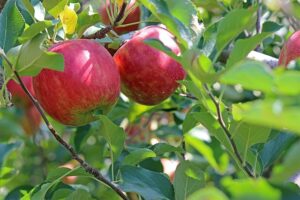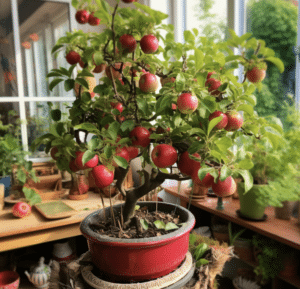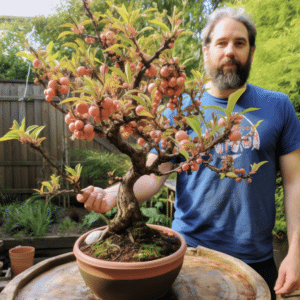Introduction – Home Grown vs Distantly Sourced Fruit
Enjoying fresh fruit from your tree is a great way to get vitamins and minerals essential to good health and has the potential to reduce carbon emissions due to transportation of distantly sourced fruit.
Planting and caring for a fruit tree is not difficult, and the rewards are many. Fresh fruits contain natural sugars, fiber, and vitamins that help you maintain a healthy diet.
In addition, homegrown fruit tastes great and is usually fresher and cheaper than store-bought fruit. There are many low-maintenance fruit trees available for the home gardener.

Before planting a fruit tree, choosing the right tree for your climate and space is important. Consider the mature height and spread of the tree, its cold hardiness, and disease resistance.
Once you have selected a tree, purchase it from a reputable nursery or garden center. Be sure to plant your tree in a sunny location with well-drained soil. Most fruit trees need at least six hours of sunlight daily to produce a good fruit crop.
In this article, we will discuss some low-maintenance fruit trees suitable for home gardens.
10 Low-Maintenance Fruit Trees
Many homeowners may think that growing fruit trees require constant pruning and upkeep, but some varieties require little maintenance. Here are 10 low-maintenance fruit trees that you can grow easily:
1. Dwarf Apple Trees

If you’re looking to add fruit trees to your garden without the hassle of extensive care, dwarf apple trees are an excellent choice. These compact trees offer a range of benefits that make them ideal for low-maintenance gardening.
Size and Manageability
Dwarf apple trees typically reach a height of 6 to 10 feet, making them ideal for small spaces. Their manageable size allows for easy pruning and harvesting, a feature that is particularly beneficial for those with limited gardening experience or space.
Disease and Pest Resistance
Certain varieties like Liberty, Freedom, and Enterprise are known for their resistance to common apple tree diseases such as scab and cedar apple rust. This natural resistance makes them easier to protect from pests and diseases, reducing the need for chemical treatments.
Yield and Maturity
Contrary to the notion that dwarf apple trees produce larger fruits, they actually produce full-sized, high-quality fruits similar to those of standard apple trees. What sets them apart is their quicker fruit-bearing maturity, often starting to produce within 2-3 years of planting. This offers gardeners a quicker return on investment.
Water Efficiency
Dwarf apple trees are generally more water-efficient than their standard counterparts. After the first growing year, an inch of rainfall every 10 days is usually sufficient. This makes them a sustainable choice, especially in areas with water restrictions.
Conclusion
Planting a dwarf apple tree in your yard or garden is not only a simple and effective way to enjoy homegrown fruits but also a smart choice for those looking for low-maintenance gardening options. By considering these features, you can enjoy the benefits of fresh, delicious apples without the extensive care often required by larger, standard apple trees.
2. Peach Trees

If you’re interested in cultivating fruit trees but are constrained by space or are looking for easier maintenance, dwarf peach trees are an excellent option. These trees offer a variety of benefits that make them well-suited for low-maintenance gardening.
Size and Manageability
Dwarf peach trees typically grow to a height of 6 to 10 feet, making them ideal for small gardens or even container planting. Their compact size allows for easy pruning and harvesting without the need for a ladder.
Climate Tolerance
Dwarf peach trees are moderately tolerant of cold temperatures and are suitable for USDA plant hardiness zones 5 through 9. Some varieties, like ‘Reliance,’ are even hardy enough to withstand winters in zone 4.
Disease and Pest Resistance
While the article did not specifically mention disease resistance, some varieties like ‘Intrepid’ are noted for being disease-resistant. This makes them easier to care for and reduces the need for chemical treatments.
Yield and Maturity
Dwarf peach trees produce fruit within a year or two, compared to about three years for full-size peach trees. Varieties like ‘El Dorado’ and ‘O’Henry’ offer medium to large-sized fruits, making them not only low-maintenance but also high-yielding.
Fruit Varieties and Flavor
Dwarf peach trees come in a range of fruit types and flavors. For example, ‘Golden Gem’ is favored for its excellent flavor, while ‘Donut’ produces unique donut-shaped fruits. ‘Redhaven’ and ‘Halloween’ offer smooth-skinned peaches with creamy yellow flesh.
Conclusion
Dwarf peach trees are a fantastic choice for those looking for a low-maintenance, high-yield fruit tree. Their compact size, climate tolerance, and quicker fruit-bearing maturity make them an ideal option for both novice and experienced gardeners.
3. Plum Trees
When adding fruit trees to the backyard, many homeowners worry about the level of upkeep and maintenance required. However, plum trees offer a solution to this concern.
These low-maintenance fruit trees are relatively hardy and have greater disease resistance than their counterparts. In addition, they only require minimal pruning and can adapt well to various types of soil. As a bonus, plum trees add visual interest with their delicate spring blossoms and provide tasty fruits for enjoyment throughout the summer and fall.
4. Apricot Trees
Apricot trees offer many benefits for the home gardener, not least their low-maintenance nature. These fruit trees require minimal pruning and can tolerate various soil types and climates.
Regarding harvesting, apricots are easily picked by hand from their branches and have a longer shelf life than some other popular fruits, such as strawberries or blueberries.
Additionally, apricot trees provide beautiful blossoms in the springtime and serve as wonderful landscape features for outdoor spaces. It’s a versatile and low-maintenance addition that will bring delicious fruits and visual interest to your garden.
5. Cherry Trees
Cherry trees are one of the best low-maintenance fruit trees you can grow in your garden. These beautiful trees are easy to care for and provide an abundance of delicious fruits that can be enjoyed fresh or used in pies, jams, and other desserts.
Cherry trees come in different colors, including white, pink, and red. They also have different flavors, such as sweet or tart. When choosing a cherry tree for your garden, select one that is disease resistant.
6. Fig Trees
Unlike other fruit trees that require frequent pruning and spraying, fig trees can thrive with minimal intervention. Simply plant them in well-drained soil and give them regular water and fertilization.
Like most plants, they may need some protection from extreme temperatures or pests, but overall they are quite resilient.
Some fig varieties can even handle brief periods of drought without suffering long-term damage. And if you have limited yard space, no worries – figs can thrive in large containers and make great additions to any urban garden.
7. Lemon Trees
Lemon trees are home gardeners’ dreams come true – they require low maintenance and can thrive in various soil types and climates. These versatile trees can also be planted in containers and brought indoors during cold weather, making them a perfect option for those with limited outdoor space.
Lemon trees provide delicious fruit, and their fragrant white blooms also add a lovely scent to any yard or patio. Plus, their dark green leaves make for beautiful landscaping all year round. With a little care and love, a single lemon tree can provide an endless supply of tangy citrus fruits for years.
8. Pomegranate Trees
Pomegranate trees are often overlooked in favor of more popular fruit trees such as apple or citrus. Still, their low maintenance needs make them a great addition to any backyard orchard. Generally drought-tolerant and disease-resistant, the pomegranate tree simply requires full sun and well-drained soil.
They thrive in warmer climates and can tolerate brief periods of low temperatures. As for pruning and pest control, minimal attention is necessary thanks to the thick skin of their fruit and the tree’s tendency to produce fewer low-hanging branches.
Plus, with their gorgeous flowers and attractive dark green foliage, pomegranate trees offer visual appeal in addition to delicious fruit.
9. Mulberry Trees
If you’re in the market for a low-maintenance fruit tree that offers both visual appeal and a bounty of tasty fruit, consider planting a mulberry tree. These deciduous trees are available in a variety of species, including white (Morus alba), red (Morus rubra), and black (Morus nigra), each producing berries with distinct flavors and appearances.
What sets the mulberry tree apart from many other fruit trees is its minimal upkeep requirements. Unlike apple or peach trees, which often demand regular pruning, fertilization, and disease management, mulberry trees are comparatively hassle-free.
They are highly adaptable to different soil conditions, ranging from sandy to clayey, and are generally more resistant to common tree diseases and pests like aphids and scale insects.
One of the most remarkable features of mulberry trees is their longevity. Some varieties have been known to live for over two centuries, making them not just a short-term addition to your garden, but a legacy that can be passed down through generations.
10. Mango Trees
Mango trees are a low-maintenance fruit option for any home orchard. They require minimal pruning and can tolerate a wide range of soil types. In addition, they are resistant to most common diseases and pests, making them an easy choice for novice gardeners.
These tropical trees also add aesthetic value with their lush green leaves and fragrant blooms. Harvesting a mango tree’s bounty is simple, as the fruit easily detaches from the stem when ripe. Plus, who can resist that sweet, juicy taste?
If you’re looking for a low-maintenance fruit tree to add to your garden, consider planting a mango tree! Not only will it provide delicious fruit, but it will also bring beauty to your landscape.
In Conclusion – Low Maintenance Fruit Trees
In conclusion, there are many benefits to planting low-maintenance fruit trees. Not only do they require minimal care, but they also provide delicious fruit and add aesthetic value to any yard or garden.
If you’re looking for an easy way to enjoy fresh fruit, consider planting one of these 10 low-maintenance varieties in your home orchard. Thanks for reading!
